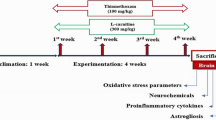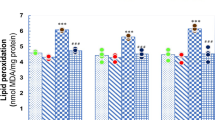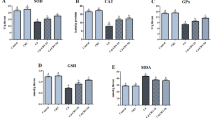Abstract
Chlorpyrifos (CPF) is a widely used organophosphate insecticide with several harmful effects. N-acetylcysteine (NAC) represents an ideal antixenobiotic; it can directly enter endogenous biochemical processes and is used as adjunctive treatment for psychiatric disorders. We aimed to evaluate the neuroprotective effect of NAC as an antioxidant drug against CPF-induced neurotoxicity in adult male albino rat brains. Twenty-eight male Wister rats were allocated into four groups (n = 7) and were administered the following for 28 days: group I (control group), physiological saline (0.9% NaCl); group II (CPF group), 10 mg/kg body weight (BW) CPF; group III (NAC group), 100 mg/kg BW NAC; and group VI (CPF+NAC group), NAC 1 h before CPF. CPF intoxication resulted in acetylcholinesterase inhibition, reduced glutathione content, and elevated levels of malondialdehyde and nitric oxide, which are oxidative stress biomarkers. CPF also depleted the activity of antioxidant enzymes, superoxide dismutase and catalase, and levels of inflammatory mediators, tumor necrosis factor-α, interleukin (IL)-6, and IL-1β. Levels of vascular endothelial growth factor, Bax, and the proapoptotic caspases-3 also increased, while brain-derived neurotrophic factor level decreased. Additionally, CPF significantly diminished Bcl-2 (an antiapoptotic protein) in rat brain cortical tissue. NAC treatment was found to protect brain tissue by reversing the CPF-induced neurotoxicity. Our results show the antioxidant, antiinflammatory, and antiapoptotic effects of NAC on CPF-induced neurotoxicity in rat brain tissue.








Similar content being viewed by others
References
Abdel Moneim AE (2013) The neuroprotective effects of purslane (Portulaca oleracea) on rotenone-induced biochemical changes and apoptosis in brain of rat. CNS Neurol Disord Drug Targets 12(6):830–841
Abdel Moneim AE (2016) Indigofera oblongifolia prevents lead acetate-induced hepatotoxicity, oxidative stress, fibrosis and apoptosis in rats. PLoS One 11:e0158965
Abdel-Daim MM, Dessouki AA, Abdel-Rahman HG, Eltaysh R, Alkahtani S (2019) Hepatorenal protective effects of taurine and N-acetylcysteine against fipronil-induced injuries: the antioxidant status and apoptotic markers expression in rats. Sci Total Environ 650:2063–2073
Aebi H (1984) Catalase in vitro. Methods Enzymol 105:121–126
Al Omairi NE, Al-Brakati AY, Kassab RB, Lokman MS, Elmahallawy EK, Amin HK, Abdel Moneim AE (2019) Soursop fruit extract mitigates scopolamine-induced amnesia and oxidative stress via activating cholinergic and Nrf2/HO-1 pathways. Metab Brain Dis. https://doi.org/10.1007/s11011-019-00407-2
Almeer RS, Kassab RB, AlBasher GI, Alarifi S, Alkahtani S, Ali D, Abdel Moneim AE (2018) Royal jelly mitigates cadmium-induced neuronal damage in mouse cortex. Mol Biol Rep 46(1):119–131
Aruoma OI, Laughton MJ, Halliwell B (1989) Carnosine, homocarnosine and anserine: could they act as antioxidants in vivo? Biochem J 264:863–869
Astiz M, de Alaniz MJ, Marra CA (2012) The oxidative damage and inflammation caused by pesticides are reverted by lipoic acid in rat brain. Neurochem Int 61:1231–1241
Basaure P, Guardia-Escote L, Cabre M, Peris-Sampedro F, Sanchez-Santed F, Domingo JL, Colomina MT (2019) Learning, memory and the expression of cholinergic components in mice are modulated by the pesticide chlorpyrifos depending upon age at exposure and apolipoprotein E (APOE) genotype. Arch Toxicol 93(3):693–707
Basha PM, Poojary A (2011) Chlorpyrifos induced region specific vulnerability in rat CNS and modulation by age and cold stress: an interactive study. Neurochem Res 36:241–249
Basha PM, Poojary A (2014) Mitochondrial dysfunction in aging rat brain regions upon chlorpyrifos toxicity and cold stress: an interactive study. Cell Mol Neurobiol 34:737–756
Bavarsad Shahripour R, Harrigan MR, Alexandrov AV (2014) N-acetylcysteine (NAC) in neurological disorders: mechanisms of action and therapeutic opportunities. Brain Behav 4:108–122
Bhatti J, Nascimento B, Akhtar U, Rhind SG, Tien H, Nathens A, da Luz LT (2017) Systematic review of human and animal studies examining the efficacy and safety of N-acetylcysteine (NAC) and N-acetylcysteine amide (NACA) in traumatic brain injury: impact on neurofunctional outcome and biomarkers of oxidative stress and inflammation. Front Neurol 8:744
Blanco J, Mulero M, Lopez M, Domingo JL, Sanchez DJ (2011) BDE-99 deregulates BDNF, Bcl-2 and the mRNA expression of thyroid receptor isoforms in rat cerebellar granular neurons. Toxicology 290:305–311
Cardona D, Lopez-Crespo G, Sanchez-Amate MC, Flores P, Sanchez-Santed F (2011) Impulsivity as long-term sequelae after chlorpyrifos intoxication: time course and individual differences. Neurotox Res 19:128–137
Cardona D, Lopez-Granero C, Canadas F, Llorens J, Flores P, Pancetti F, Sanchez-Santed F (2013) Dose-dependent regional brain acetylcholinesterase and acylpeptide hydrolase inhibition without cell death after chlorpyrifos administration. J Toxicol Sci 38:193–203
Chen G, Shi J, Hu Z, Hang C (2008) Inhibitory effect on cerebral inflammatory response following traumatic brain injury in rats: a potential neuroprotective mechanism of N-acetylcysteine. Mediat Inflamm 716458
das Neves Duarte JM, Kulak A, Gholam-Razaee MM, Cuenod M, Gruetter R, Do KQ (2012) N-acetylcysteine normalizes neurochemical changes in the glutathione-deficient schizophrenia mouse model during development. Biol Psychiatry 71:1006–1014
Duramad P, Tager IB, Holland NT (2007) Cytokines and other immunological biomarkers in children's environmental health studies. Toxicol Lett 172:48–59
Ellman GL (1959) Tissue sulfhydryl groups. Arch Biochem Biophys 82:70–77
Ellman GL, Courtney KD, Andres V Jr, Feather-Stone RM (1961) A new and rapid colorimetric determination of acetylcholinesterase activity. Biochem Pharmacol 7:88–95
Farbiszewski R, Witek A, Skrzydlewska E (2000) N-acetylcysteine or trolox derivative mitigate the toxic effects of methanol on the antioxidant system of rat brain. Toxicology 156:47–55
Finamor IA, Ourique GM, Pes TS, Saccol EM, Bressan CA, Scheid T, Baldisserotto B, Llesuy SF, Partata WA, Pavanato MA (2014) The protective effect of N-acetylcysteine on oxidative stress in the brain caused by the long-term intake of aspartame by rats. Neurochem Res 39:1681–1690
Garcia-Garcia CR, Parron T, Requena M, Alarcon R, Tsatsakis AM, Hernandez AF (2016) Occupational pesticide exposure and adverse health effects at the clinical, hematological and biochemical level. Life Sci 145:274–283
Geller HM, Cheng KY, Goldsmith NK, Romero AA, Zhang AL, Morris EJ, Grandison L (2001) Oxidative stress mediates neuronal DNA damage and apoptosis in response to cytosine arabinoside. J Neurochem 78:265–275
Green LC, Wagner DA, Glogowski J, Skipper PL, Wishnok JS, Tannenbaum SR (1982) Analysis of nitrate, nitrite, and [15 N]nitrate in biological fluids. Anal Biochem 126:131–138
Hicdonmez T, Kanter M, Tiryaki M, Parsak T, Cobanoglu S (2006) Neuroprotective effects of N-acetylcysteine on experimental closed head trauma in rats. Neurochem Res 31:473–481
Karalija A, Novikova LN, Kingham PJ, Wiberg M, Novikov LN (2012) Neuroprotective effects of N-acetyl-cysteine and acetyl-L-carnitine after spinal cord injury in adult rats. PLoS One 7:e41086
Kaur S, Singla N, Dhawan DK (2019) Neuro-protective potential of quercetin during chlorpyrifos induced neurotoxicity in rats. Drug Chem Toxicol:1–11
Kerksick C, Willoughby D (2005) The antioxidant role of glutathione and N-acetyl-cysteine supplements and exercise-induced oxidative stress. J Int Soc Sports Nutr 2:38–44
Kim J, Lim W, Ko Y, Kwon H, Kim S, Kim O, Park G, Choi H (2012) The effects of cadmium on VEGF-mediated angiogenesis in HUVECs. J Appl Toxicol 32:342–349
Landrigan PJ, Lambertini L, Birnbaum LS (2012) A research strategy to discover the environmental causes of autism and neurodevelopmental disabilities. Environ Health Perspect 120:a258–a260
Lassiter TL, Ryde IT, Levin ED, Seidler FJ, Slotkin TA (2010) Neonatal exposure to parathion alters lipid metabolism in adulthood: interactions with dietary fat intake and implications for neurodevelopmental deficits. Brain Res Bull 81:85–91
Lee JE, Park JH, Shin IC, Koh HC (2012) Reactive oxygen species regulated mitochondria-mediated apoptosis in PC12 cells exposed to chlorpyrifos. Toxicol Appl Pharmacol 263:148–162
Lee JE, Park JH, Jang SJ, Koh HC (2014) Rosiglitazone inhibits chlorpyrifos-induced apoptosis via modulation of the oxidative stress and inflammatory response in SH-SY5Y cells. Toxicol Appl Pharmacol 278:159–171
Liu J, Zhu HX, Fu WL, Xu XW, Yang JZ, Dai D, Li Y (2019) Downregulated hippocampal expression of brain derived neurotrophic factor and tyrosine kinase B in a rat model of comorbid epilepsy and depression. Neurol Res:1–9
Maroni M, Colosio C, Ferioli A, Fait A (2000) Biological monitoring of pesticide exposure: a review. Introduction Toxicology 143:1–118
Mokhtari V, Afsharian P, Shahhoseini M, Kalantar SM, Moini A (2017) A review on various uses of N-acetyl cysteine. Cell J 19:11–17
Moneim AE (2015) Oxidant/antioxidant imbalance and the risk of Alzheimer's disease. Curr Alzheimer Res 12:335–349
Ncibi S, Ben Othman M, Akacha A, Krifi MN, Zourgui L (2008) Opuntia ficus indica extract protects against chlorpyrifos-induced damage on mice liver. Food Chem Toxicol 46:797–802
Nita M, Grzybowski A (2016) The role of the reactive oxygen species and oxidative stress in the pathomechanism of the age-related ocular diseases and other pathologies of the anterior and posterior eye segments in adults. Oxidative Med Cell Longev 3164734
Ogut S, Gultekin F, Kisioglu AN, Kucukoner E (2011) Oxidative stress in the blood of farm workers following intensive pesticide exposure. Toxicol Ind Health 27:820–825
Ohkawa H, Ohishi N, Yagi K (1979) Assay for lipid peroxides in animal tissues by thiobarbituric acid reaction. Anal Biochem 95:351–358
Pandya JD, Readnower RD, Patel SP, Yonutas HM, Pauly JR, Goldstein GA, Rabchevsky AG, Sullivan PG (2014) N-acetylcysteine amide confers neuroprotection, improves bioenergetics and behavioral outcome following TBI. Exp Neurol 257:106–113
Quintana MM, Rivero Osimani V, Magnarelli G, Rovedatti MG, Guinazu N (2018) The insecticides chlorpyrifos and acetamiprid induce redox imbalance in umbilical cord blood erythrocytes in vitro. Pestic Biochem Physiol 148:87–92
Repnik U, Hafner Cesen M, Turk B, 2014 Lysosomal membrane permeabilization in cell death: concepts and challenges. Mitochondrion 19 Pt A, 49-57
Ross SM, McManus IC, Harrison V, Mason O (2013) Neurobehavioral problems following low-level exposure to organophosphate pesticides: a systematic and meta-analytic review. Crit Rev Toxicol 43:21–44
Roth TL, Nayak D, Atanasijevic T, Koretsky AP, Latour LL, McGavern DB (2014) Transcranial amelioration of inflammation and cell death after brain injury. Nature 505:223–228
Samsel A, Seneff S (2015) Glyphosate, pathways to modern diseases III: manganese, neurological diseases, and associated pathologies. Surg Neurol Int 6:45
Shou L, Bei Y, Song Y, Wang L, Ai L, Yan Q, He W (2019) Nrf2 mediates the protective effect of edaravone after chlorpyrifos-induced nervous system toxicity. Environ Toxicol 34(5):626–633
Slotkin TA (2011) Does early-life exposure to organophosphate insecticides lead to prediabetes and obesity? Reprod Toxicol 31:297–301
Stipanuk MH, Dominy JE Jr, Lee JI, Coloso RM (2006) Mammalian cysteine metabolism: new insights into regulation of cysteine metabolism. J Nutr 136:1652S–1659S
Suke SG, Ahmed RS, Pathak R, Tripathi AK, Banerjee BD (2008) Attenuation of phosphamidon-induced oxidative stress and immune dysfunction in rats treated with N-acetylcysteine. Braz J Med Biol Res 41:765–768
Sun Y, Oberley LW, Li Y (1988) A simple method for clinical assay of superoxide dismutase. Clin Chem 34:497–500
Sun L, Gu L, Wang S, Yuan J, Yang H, Zhu J, Zhang H (2012) N-acetylcysteine protects against apoptosis through modulation of group i metabotropic glutamate receptor activity. PLoS One 7:e32503
Troy CM, Derossi D, Prochiantz A, Greene LA, Shelanski ML (1996) Downregulation of Cu/Zn superoxide dismutase leads to cell death via the nitric oxide-peroxynitrite pathway. J Neurosci 16:253–261
Wang WY, Tan MS, Yu JT, Tan L (2015) Role of pro-inflammatory cytokines released from microglia in Alzheimer's disease. Ann Transl Med 3:136
Yao X, Miao W, Li M, Wang M, Ma J, Wang Y, Miao L, Feng H (2010) Protective effect of albumin on VEGF and brain edema in acute ischemia in rats. Neurosci Lett 472:179–183
Yi JH, Hoover R, McIntosh TK, Hazell AS (2006) Early, transient increase in complexin I and complexin II in the cerebral cortex following traumatic brain injury is attenuated by N-acetylcysteine. J Neurotrauma 23:86–96
Yu ZP, Matsuoka M, Wispriyono B, Iryo Y, Igisu H (2000) Activation of mitogen-activated protein kinases by tributyltin in CCRF-CEM cells: role of intracellular Ca(2+). Toxicol Appl Pharmacol 168:200–207
Zhang P, Zhong S, Wang G, Zhang SY, Chu C, Zeng S, Yan Y, Cheng X, Bao Y, Hocher B, Yang X (2018) N-acetylcysteine suppresses lps-induced pathological angiogenesis. Cell Physiol Biochem 49:2483–2495
Author information
Authors and Affiliations
Corresponding author
Ethics declarations
Conflict of interest
The authors declare that they have no conflict of interest.
Additional information
Responsible editor: Philippe Garrigues
Publisher’s note
Springer Nature remains neutral with regard to jurisdictional claims in published maps and institutional affiliations.
Rights and permissions
About this article
Cite this article
Mahmoud, S.M., Abdel Moneim, A.E., Qayed, M.M. et al. Potential role of N-acetylcysteine on chlorpyrifos-induced neurotoxicity in rats. Environ Sci Pollut Res 26, 20731–20741 (2019). https://doi.org/10.1007/s11356-019-05366-w
Received:
Accepted:
Published:
Issue Date:
DOI: https://doi.org/10.1007/s11356-019-05366-w




